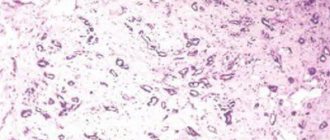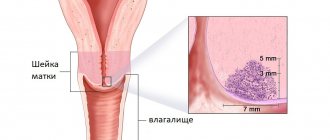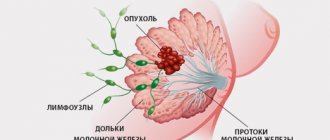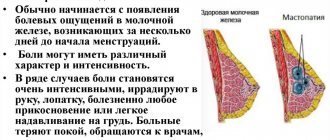In women, it is not always possible to detect symptoms of breast cancer in a timely manner, resulting in a disappointing prognosis. Breast cancer (BC) is the most common oncological pathology among representatives of the fairer sex of any age. The clinical picture of the disease may differ for each patient, depending on the type and degree of cancer. As soon as the first symptoms are identified, you should immediately contact an oncologist and carry out the necessary treatment.
When breast cancer is advanced, a woman is likely to develop distant metastases, leading to the death of the patient.
Why it occurs: reasons
Every patient should know what oncology in the mammary glands looks like, since no one is protected from the development of cancer. The pathology develops quickly and leads to irreversible consequences. Doctors are still figuring out the true reasons why a malignant tumor forms in the mammary glands. Oncological disease is more likely to manifest itself in old age. There are also other risk factors that contribute to the development of cancer in the female breast area:
- long-term hormonal therapy;
- heredity;
- the negative impact of radiation or radiation exposure during the treatment of another form of cancer;
- problems with excess weight;
- early menstrual cycle or late menopause;
- late first pregnancy - after 35 years of age;
- bad habits;
- symptoms of diabetes;
- work on night shifts;
- mechanical damage to the mammary gland.
Cell degeneration occurs not only under the influence of pathogenic factors, but also due to gene mutation.
Even in the presence of provoking factors, the pathological process of proliferation of malignant cells does not manifest itself in all cases. In most cases, breast cancer occurs due to mutations in the BRCA1 and BRCA2 genes. The likelihood of cancer progression increases by 65% with mutational changes in BRCA1. If a woman is a carrier of the BCRA2 mutation, then cancer occurs in 45% of cases.
Etiology of breast cancer
Main points of etiopathogenesis:
- Carcinogens
- Ionizing radiation
- Hereditary predisposition
- Precancerous diseases:
Optional
- diffuse mastopathy
- fibroadenoma
Obligate
- intraductal papilloma
- nodular mastopathy
Biological carcinogens are not associated with the occurrence of breast cancer.
Predisposing factors for the development of breast cancer
- social and household – in cities the risk of getting sick is increased.
- Reproductive – increased risk with early onset of menstruation and late menopause (estrogen window). Before 35 years of age, each pregnancy protects against breast cancer; after 35 years of age, it is a risk factor.
- Previous diseases - mastopathy, postpartum mastitis, lactation mastitis, treated conservatively, etc.
- Sexual nature – lack of sexual activity, dissatisfaction, late onset (30 years), decreased libido, contraception (taking oral contraceptives before the 1st pregnancy increases the risk).
- Endocrine – obesity 70 kg or more, hypofunction of the thyroid gland, birth of 2 large children, height 170 or more.
- Genetic predisposition – BRCA-1,2 gene
- Precancerous diseases.
- Gynecological diseases.
How to recognize the symptoms?
It is usually difficult to detect breast cancer at an early stage. An extensive clinical picture begins at a later stage. A characteristic sign of a cancerous tumor is pain. At first, the woman notices that one gland hurts a little; as the disease progresses, the unpleasant sensations intensify and disturb not only during the day, but also at night. Subsequently, a breast tumor is accompanied by the following symptoms:
- the appearance of a lump or compaction in the affected breast;
- discomfort;
- deformation processes in the nipple area, often it retracts;
- impaired breast shape and the appearance of asymmetry;
- pathological discharge from the nipple, having a reddish or yellow tint;
- wrinkled skin in the area of the tumor;
- swelling in the mammary gland, spreading to the shoulder.
As soon as the first signs of breast cancer are detected, you should immediately consult a doctor. When the course is advanced, the lymph nodes under the armpit and in the area of the collarbone become greatly enlarged, which aggravates the course of the pathology.
Diagnosis of breast cancer
Diagnosis of breast cancer consists of 2 stages: establishing and clarifying. Based on complaints, palpation and examination of the breast, life history, instrumental research methods, visualization and biopsy data. So let's start with the establishing stage.
Complaints in breast cancer
Primary:
- presence of a tumor
- asymmetry
- nipple retraction
- hyperemia, swelling of the gland
- lemon peel
- nipple discharge
- restriction of gland mobility (adhesive to the pectoral muscles)
Secondary:
- enlarged axillary lymph nodes
- ulceration
- swelling of the hand, etc.
- general symptoms – not expressed in primary patients (only with generalization)
History of the disease
- onset of the disease?
- duration?
- dynamics of the disease?
- what was the treatment?
- did the treatment help?
- what examinations were carried out?
Anamnesis of life
- Hereditary predisposition
- Carcinogenic load
- Precancerous diseases
- Concomitant somatic pathology
Physical examination
Breast examination
- deformation
- hyperemia
- rugosity
- lemon peel
- asymmetry
- nipple retraction
- discharge
Palpation of the mammary glands
- Krause's sign - thickening of the skin of the areola and nipple
- Pribram's sign - when the nipple is pulled, the tumor moves to that side
- Koenig's sign (palm sign) - a tumor palpable in the palm (benign disappears, malignant does not)
- Payr's symptom - perpendicular folds.
Lymph nodes in breast cancer
- dense
- painless
- rounded
- enlarged
- not fused to surrounding tissues, but can be fused to each other and form conglomerates.
Visualization
Palpation of the gland
- tumor with blurred, indistinct edges
- compacted
- limited
- displaceable
- painless
Mammography
Direct signs:
- irregular star-shaped shadow with unclear contours
- maybe a path to the root
- microcalcifications
Indirect signs:
- secondary thickening of the skin, simulating nipple retraction
- vascularization
Ultrasound is informative up to 35 years of age, after that only mammography.
Ductography – in the presence of nipple discharge
Verification
- cytological
- histological
Material collection methods
Tumor:
- examination of pathological discharge from the nipple
- smear-imprint of ulcers
- percutaneous fine-needle puncture biopsy of a tumor under finger or ultrasound control
- Trephine biopsy under ultrasound control
- Incisional or excisional (type of sectoral resection) tumor biopsy
Pleura
- pleural puncture
- 1st portion of liquid – culture for sterility
- The remaining liquid is for centrifugation and examination of the sediment for the presence of atypical cells
Lymph nodes
- Percutaneous fine needle biopsy under finger or ultrasound control
- Trephine biopsy under ultrasound control
- Incisional or excisional biopsy
Abdomen:
- Laparocentesis
- Culdocentesis
- Laparoscopy
- Laparotomy (the algorithm is the same as for pleurisy)
Liver:
- Percutaneous fine needle biopsy under finger or ultrasound control
- Trephine biopsy under ultrasound control
- Laparoscopy
- laparotomy
Clarifying stage
Local tumor spread
- CT
- MRI
Regional metastases
- palpation
- Ultrasound
Distant metastases
Lungs
- radiography
- CT
Liver:
- Ultrasound
Bones:
- radiography
- CT
- MRI
Main stages
Symptoms of breast cancer differ for each patient, depending on the stage of the pathology. There is the following classification of degrees of oncology, indicated in the table:
| Stage | Tumor size, cm | Peculiarities |
| 0 | No more than 1 cm | At this stage, ductal or lobular carcinoma is diagnosed |
| Doesn't go beyond your boundaries | ||
| I | Within 2 | Cancer cells spread to nearby healthy cells |
| II | 2—5 | Invasive breast cancer |
| Involvement of nearby lymph nodes in the pathological process | ||
| IIIA | More than 5 | Soldering of lymph nodes and nearby tissues |
| IIIB | Growth of a cancerous tumor into the skin of the breast and chest | |
| In more than 5% of cases, inflammatory cancer is recorded | ||
| The skin around the breast turns red | ||
| IV | Metastases to nearby and distant internal organs and lymph nodes |
Tumor
Let's consider the features of a breast tumor that affect life expectancy.
Hormonal sensitivity of the tumor
This feature is determined after a biopsy of the area suspicious for cancer. If the material contains receptors (cells with susceptibility to certain substances) that are sensitive to the female sex hormones estrogens and gestagens, the tumor is said to be hormonally dependent. This form of the disease progresses quickly in young women and slowly in older women. This type responds well to treatment by suppressing female hormonal levels, since the tumor is deprived of growth factors.
Her2neu markers
Selected forms of breast cancer develop with the release of special proteins into the blood - Her2neu markers. Their level in the blood plasma gives an idea of the malignancy and aggressiveness of the tumor process. If the test for the indicator is positive, the likelihood of early metastasis and rapid growth of the lesion increases significantly. The presence of the marker also determines the characteristics of chemotherapy. Such tumors are not sensitive to standard treatment regimens.
Stage of the oncological process
The stage of the detected disease is important. The earlier the diagnosis is made, the better the prognosis for cure and survival. Breast cancer develops in 5 stages:
- Initial, or zero. The tumor barely begins in the mammary gland. At this stage, the woman does not express complaints. This is an incidental finding during a routine examination or annual examination. The probability of cure at stage zero is high – 98%.
- First stage. The stage is characterized by a lesion measuring up to 2 centimeters. A woman can independently detect a neoplasm in the breast tissue during self-examination. The chances of a complete cure are also high - 96%.
- Second stage. The tumor is already of impressive size: 2-5 centimeters. This stage is characterized by enlargement of the axillary lymph nodes. This happens due to metastases. The probability of cure is still high and is 90%. Any woman can identify the second stage in herself. If you detect suspicious formations in the breast tissue, you should consult a doctor without wasting time.
- Third stage. It is determined not by the size of the tumor and the growth rate, but by the damage to distant lymph nodes by metastases. In addition to the axillary ones, other lymph nodes also enlarge. Damage to neighboring organs (liver, lungs, bones, brain) has not yet been detected. This stage is divided into two more degrees: A and B. Survival rate when diagnosed at this stage is lower and amounts to 70%.
- Fourth stage. At this stage, other organs are already involved in the oncological process. Life expectancy is short and is determined by the degree of damage to target organs. The chances of a cure are small, but they are there – 10%.
Type of breast cancer
The rate of development of the breast tumor process from stage to stage is influenced by the histological (cellular) type of cancer:
- Erysipeloid (erysipelas-like) cancer. It begins with swelling of the skin of the mammary gland and an increase in body temperature. A focus of redness with clear wavy edges appears on the skin of the chest, as with erysipelas. No lumps in the breast tissue are detected. It is often confused with erysipelas of the mammary gland and the correct diagnosis is not made for a long time. Characterized by rapid metastasis to lymph nodes and other organs.
- Paget's cancer (nipple cancer). This variety is named after the author who first described the disease. The malignant process first originates in the ducts, later changes appear on the nipple and halo. Peeling appears, which many do not notice. Next, swelling, ulcers and lumps around the nipple develop. The described form of oncology is non-invasive and does not affect the glandular tissue of the breast. Much later in time the lymph nodes are affected. Most often, this breast cancer develops in women aged 50-60 years. Sometimes it is diagnosed in men. Treats effectively.
- Infiltrative-edematous cancer. The mentioned form occurs during breastfeeding and pregnancy. The mammary gland swells, increasing in size. The skin of the affected breast is hyperemic (red). The process quickly spreads to the lymph nodes. Upon palpation, a compaction is felt in the gland, which quickly increases in size. The described type of tumor is dangerous and is often mistaken for postpartum mastitis. There are difficulties in treating the form: the tumor is resistant to standard conservative therapy.
- Inflammatory cancer. It manifests itself as swelling, pain, and a feeling of heaviness in the mammary gland. The skin of the affected breast turns red and sometimes acquires a bluish tint. The symptom of an inverted nipple develops. This form is often confused with mastitis (inflammation of the mammary gland), which makes early diagnosis difficult. It is not possible to detect focal compaction due to edema in the gland tissue. The tumor develops rapidly and metastasizes to the lymph nodes and neighboring tissues. Often the diagnosis is made already at stages 3-4. This is the danger of this form.
- Armor cancer. Initially, the process is characterized by the presence of several compactions in the gland tissue, painless on palpation. Later, specific symptoms appear. The mammary gland decreases in size, the chest loses mobility, as the process quickly spreads to neighboring bones and tissues, linking everything into a single conglomerate. The skin becomes dense, does not move, resembles a crust or shell. All this makes breathing difficult. In a short period of time, the second breast is involved in the process. When the process is diagnosed in the early stages, the prognosis is favorable.
What types and forms are there?
The malignant process is usually divided into types.
Depending on the type of breast cancer, survival and prognosis vary. The initial stage of cancer, with timely diagnosis, is more treatable than advanced stages with metastases. In medicine, there are different clinical forms of malignant tumors, which differ in symptoms. Breast cancer is divided into several types, which are listed in the table:
| Classification | Type |
| By location | Ductal |
| Lobular | |
| According to histology | Adenocarcinoma |
| Solid cancer | |
| Sarcoma | |
| By estrogen receptors | Estrogen-positive neoplasms |
| Negative | |
| By distribution | Invasive |
| Non-invasive |
How to find out about the problem: diagnostics
When the first unpleasant signs appear in the breast area, a woman should see a mammologist or oncologist. Sometimes low-grade breast cancer is detected, which is difficult to recognize even with the help of a comprehensive examination. To confirm the diagnosis, the specialist examines the affected area and collects a detailed medical history. It is possible to determine the type and degree of cancer through the following examinations:
The presence of cancer marker CA 15-3 in the blood indicates the development of pathology.
- X-rays of the breast;
- detection of tumor markers CA 15-3 in the blood;
- diagnosis of glands and lymph nodes using ultrasound waves;
- biopsy with further histology;
- ductography of the mammary gland ducts;
- immunohistochemical examination to determine the sensitivity of the neoplasm to hormonal drugs.
Necessary treatment
Breast cancer is most easily treated in the early stages of development. If the onset of pathology is diagnosed, then surgery with preservation of organs or radiation treatment is performed. In more advanced stages, a comprehensive therapeutic approach is required, including the following manipulations:
- surgical intervention;
- chemotherapy or radiation therapy;
- taking hormonal drugs.
Treatment with folk remedies for breast cancer is not only ineffective, but also dangerous. Natural components can only negatively affect cancer cells.
Breast cancer treatment
Treatment for breast cancer includes surgical methods, radiation therapy, chemotherapy, and hormone therapy. So, let's start looking in more detail at the surgical method.
Surgical method
Radical operations
The standard surgical operation used to treat breast cancer is a simple mastectomy - in case of generalization of the tumor process, infection, tumor bleeding
Advanced operations include:
- Halstead-Meyer operation - the mammary gland with the skin, pectoralis major and minor muscles, axillary, subscapular and subclavian nodes are removed as a single block.
- Peyti's operation – leaving the pectoralis major muscle
- Madden operation - both pectoral muscles are left.
For special indications, sectoral radical resection with lymphadenectomy is performed for:
- tumor location outward from the nipple or inward no more than 3 cm
- tumors no more than 3 cm2
- single regional metastases
- old age
Radiation therapy
Radiation therapy as an independent method in the treatment of breast cancer is performed:
- upon refusal of surgery
- in serious condition of the patient
Combined (with operation):
Preoperative
- tumor growth
- numerous metastases to the axillary lymph nodes,
- tumor 5 cm or more in diameter.
Postoperative
Chemotherapy
The main goal of breast cancer treatment using chemotherapy is to achieve tumor remission.
Independent chemotherapy as a treatment for breast cancer is used:
- after radical intervention
- in the presence of multiple metastases
Preventive chemotherapy is indicated:
- enlarged lymph nodes 3 cm or more
- damage to more than 25% of lymph nodes
- low- and undifferentiated cancers
- diffuse forms
In relation to surgery, chemotherapy is:
- preoperative (neoadjuvant)
- postoperative (adjuvant)
Hormone therapy
The mammary gland is a hormone-dependent organ. Prolactin is a hormone of pregnant and lactating women. Its amount is minimal at the beginning of the menstrual cycle (immediately after menstruation), increases towards the middle of the cycle, and then decreases. Hormonal treatment is a way to slow down the tumor process.
Treatment for breast cancer involves reducing estrogen production. To achieve this, it is necessary to remove the ovaries, or administer drugs that reduce the production of estrogen.
Effects on the adrenal glands
- adrenalectomy
- chemical ablation
- irradiation
Effect on the pituitary gland
- radiation ablation
- chemical ablation (Zoladex is an analogue of GnRH, with long-term use it blocks the release of its own GnRH, as a result of which the secretion of LH and FSH by the pituitary gland decreases)
Additive effects are the use of androgens, which reduce the amount of estrogens. Used in very large doses. Antagonist treatment with tamoxifen (tamoxifen is an antiestrogen).
Prednisolone is prescribed for metastases to the liver, brain, and lungs.
Treatment tactics depending on stage
- Stage I, IIa – surgical treatment
- Stage IIb, III – preoperative radiation therapy + surgery
- Stage III – preoperative chemotherapy or radiation therapy + surgery
For relapses and metastases - chemotherapy.
Five-year survival rate
- 90% – at stage I
- 80% – at stage II.
Prognosis for breast cancer
- sizes (the larger the sizes, the worse the prognosis)
- degree of differentiation
- regional lymph nodes
- sex chromatin (in tumor cells of Barr bodies) may be detectable (Barr-positive) or not detectable (Barr-negative)
- the presence of hormone receptors in the tumor.
- biological state
Possible complications
The advanced form of the disease exhibits metastasis, during which the healing process is aggravated.
If breast cancer is not detected in time and treatment is not started, then serious consequences arise, due to which patients live less. The greatest danger is presented by stages 3 and 4 of the disease, in which distant metastases appear in the kidneys, liver and other lymph nodes. Against the background of the pathology, nearby tissues become inflamed and bleeding from a cancerous tumor in the breast area is often observed.
Dependence of the rate of development of the disease on the type and stage of cancer
How the disease develops directly depends on the type of cancer. Doctors have identified the following most rapidly developing varieties of such a serious disease:
- Erysipeloid cancer. Its primary symptoms include swelling of the skin of the chest and increased body temperature. When palpated, the tumor cannot be detected. This form develops very quickly, spreading to the lymph nodes and other organs.
- Paget's cancer. With this form of cancer, the lesion occurs in the nipple and areola area. The first symptom can be called peeling, due to which many women attribute the disease to eczema. Over time, the tumor forms nodes and spreads to the lymph nodes. This form of the disease develops over several years.
- Edema cancer. This form of the disease occurs during pregnancy or breastfeeding. The entire chest area swells, and when palpated, a tumor can be detected. This type of disease occurs without severe pain, so many women are not even aware of it.
- Inflammatory cancer. This is one of the less common forms of the disease, which in all respects is similar to the development of mastitis. It is for this reason that treatment can be difficult due to an incorrect diagnosis. Also, the danger of this form of the disease lies in its rapid development, and in the later stages it cannot be treated.
- Armor cancer. As this type of disease develops, the breasts begin to decrease in size and cracks form on the nipples. The tumor begins to grow rapidly, thereby making it difficult for the woman to breathe.
Listed above are the main types of disease that women and girls most often encounter. However, the development of cancer depends not only on the form of the disease, but also on its degree.
Stages of the disease
In total, four stages of the disease are identified, each of which is divided into subgroups. The most harmless is the first stage, in which the tumor is small in size and reaches no more than 2 centimeters in diameter. In the second stage, the tumor grows, but, as a rule, does not become more than five centimeters. When the disease develops at these stages, the survival rate of women is approximately 80%, which is why these periods of the disease are considered the most harmless.
At the third stage of development of the disease, tumors can reach a size of more than five centimeters, and metastases already form in the armpits, which cannot be said about the first two stages. Starting from this period, the cancer progresses quite quickly, and the survival rate of patients is already only 50%.
At the fourth stage, the tumor can reach any size, and metastases appear not only in the armpits, but also in other parts of the body. As medical practice shows, rarely anyone managed to live more than five years after this stage. Although with complex treatment, life expectancy can be increased.
Of course, if a cancerous tumor is detected at the first stage of the disease, it can be easily treated, and therefore the patient’s life expectancy increases significantly. Basically, women who learned about the disease of the mammary glands at the initial stage were able to completely get rid of this disease. The disease of the first stage does not proceed so rapidly, and moves into the second stage gradually.
If we talk about the last stages of the disease, then they proceed rapidly, and even, one might say, aggressively. Many people die from cancer very quickly and sometimes doctors' forecasts turn out to be more optimistic.
Important! At the initial stage of development of the disease, the tumor is small in size and has a certain mobility. In later stages it becomes larger and more static.
Other factors influencing disease progression
Of course, different types and stages of cancer progress differently. Also, the course of the disease depends on treatment methods and human immunity. Doctors have discovered that some groups of tumors begin to develop rapidly after they reach a certain size.
Some formations begin to develop rapidly for no reason, spreading throughout the body.
To a large extent, everything depends on the individual characteristics of the patient. Thus, the same formations in a woman can progress differently. In order to understand the speed at which the disease develops, you need to contact an experienced doctor and begin treatment immediately.
Many people who have been diagnosed with this disease are interested in how long they have left to live. In fact, it will be difficult even for an experienced specialist to answer this question, since each case is individual. First of all, life expectancy depends on the following features:
- patient's age;
- stages of the disease;
- the presence of other diseases;
- psychological climate in the family;
- treatment.
Prognosis and prevention
Early diagnosis and properly selected treatment methods increase the chances of a favorable outcome. At stages 2-3, survival rate is 72-93%, while at the last stage the rates drop to 22%. Breast cancer can be prevented with regular self-examination. It is worth visiting a gynecologist and mammologist at least once a year, especially for women over 45 years of age. It is necessary to eat right and lead a healthy and active lifestyle. In case of hormonal imbalances, they undergo special therapy to normalize the level of hormones in the female body.










